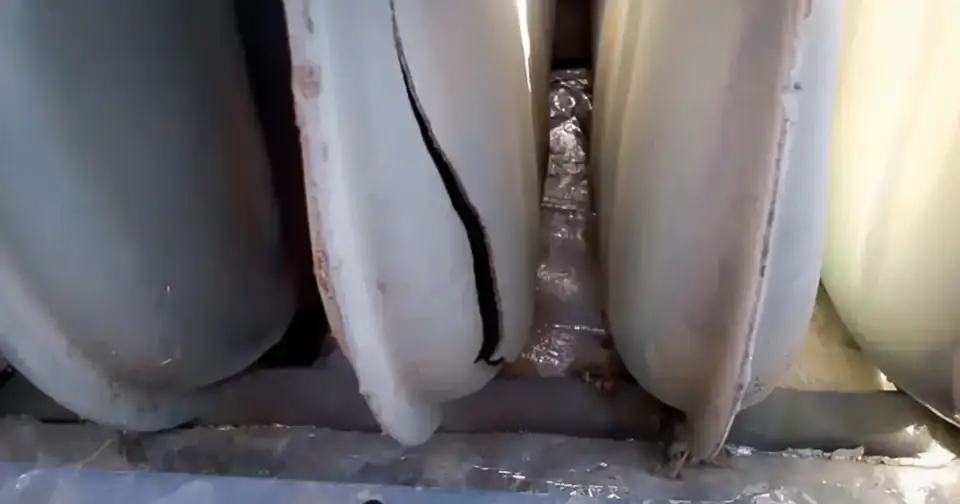The United States loses more than 400 lives per year to unintentional carbon monoxide (CO) poisoning. A significant contributor to these tragic accidents is issues with fuel-burning appliances, particularly furnaces.
One of the most critical factors in furnace-related CO poisoning is the presence of a cracked heat exchanger.
Since winter is fully upon us now, Brad feels the time has come to discuss what a furnace heat exchanger is, why they crack, how to detect a crack, and how to prevent this situation in your home.
What is a Heat Exchanger?
A furnace heat exchanger plays a pivotal role in maintaining indoor comfort during the cold season. Heat exchangers are designed to transfer heat from the burning fuel, while separating the exhaust gases from the breathable air inside your home.

There are different types of heat exchangers. Two of the most common are shell and tube heat exchangers and plate heat exchangers. The former are considered more popular due to their simplicity and cost-effectiveness, whereas the latter offer a more compact design with higher temperature capabilities.
A cracked heat exchanger can allow dangerous exhaust gases, such as carbon monoxide, to leak into your living space and pose serious health risks.
Common Causes of Heat Exchanger Cracks
Understanding the factors that lead to heat exchanger cracks is crucial for preventing these hazardous situations:
- Frequent Temperature Fluctuations: The constant expansion and contraction of the metal during heating and cooling cycles can gradually weaken the heat exchanger.
- Inadequate Furnace Maintenance: Regular furnace maintenance provided by reputable service providers is essential. Without proper upkeep, dust, moisture, and heat can contribute to rust and corrosion, weakening the metal and potentially causing cracks. Overheating, often triggered by a dirty air filter, is another vital reason for consistent maintenance.
- Age: Heat exchangers have a typical lifespan of around 15 to 18 years. If yours is older, it’s advisable to consider replacement to ensure safety.
- Manufacturing Defects: Occasionally, heat exchangers may fail due to manufacturing flaws or production issues.
Improper Installation: Incorrect installation practices can lead to cracks. Factors such as the Start-up Temperature Rise setting must be appropriately adjusted for the local elevation to prevent issues.
Types of Heat Exchanger Cracks
Identifying different types of cracks that can occur in heat exchangers is essential for assessment and safety:
- Partial (Hairline) Cracks: Initially, these cracks may not penetrate the total thickness of the metal but can expand over time due to the continuous heating and cooling cycles.
- Small (Through) Cracks: While these cracks may not be immediately visible, they can be hazardous if exhaust gases start infiltrating your home. Professional inspection is critical in such cases.
- Large (Full) Cracks: These are substantial and clearly visible, posing an imminent danger and requiring immediate heat exchanger replacement.

Detecting a Cracked Heat Exchanger
Indications that your furnace’s heat exchanger may be cracked include:
- Accumulation of soot
- Unusual, unpleasant odors resembling formaldehyde
- The presence of water under the furnace
- Household members experience symptoms like dizziness, nausea, sickness, or disorientation
- Activation of carbon monoxide detectors within your home
- Corrosion or visible cracks on other furnace components
- A visible yellow or orange flame when the furnace is operating
If you notice any of the above signs in your home, it’s very likely that you’re dealing with a cracked heat exchanger. In this case, Brad asks that you immediately call us so we can offer a definitive diagnosis and address the danger.
Preventing Heat Exchanger Cracks
Enrolling in one of our Preventive Maintenance Plans is the best way to protect your home and family from the dangers of cracked heat exchangers.
Regular inspections are essential for identifying cracks and other potential issues that may jeopardize your safety. During our inspection, if we detect a cracked heat exchanger, we will explain how to remedy the problem.
In addition to preventive maintenance, we recommend the following steps to help prevent this issue with your furnace:
- Ensure your furnace is sized correctly for the area it is heating.
- Ensure the furnace is correctly installed.
- Frequently change your furnace filters.
- Maintain cleanliness in the utility room.
- Make sure the Start-up Temperature Rise is appropriately configured for your local elevation.
The Cost of Repair
Repairing a cracked heat exchanger is generally not a feasible option. Replacement costs can often amount to several thousand dollars, with even warranty-covered replacements incurring high labor costs due to the necessity of disassembling the entire furnace unit.
Given the significant expenses involved, furnace replacement is frequently recommended, especially for units older than ten years.
Final Thoughts
A cracked heat exchanger is a serious safety hazard that can lead to carbon monoxide poisoning and potentially fatal consequences. Proactive maintenance, regular professional inspections, and prompt resolution of potential issues are essential to ensuring the safety and efficiency of your furnace and heat exchanger.
At Brad’s Heating & Air, we are committed to the safety and security of our valued customers. As always, we work hard to keep you informed of ways to enhance the life, efficiency, and safety of the HVAC system in your home.
Call us at (501) 330-8066 if you would like Brad to stop by and give your furnace a quick look. He can either put your mind at ease or, more importantly, protect the safety of your home and family!



